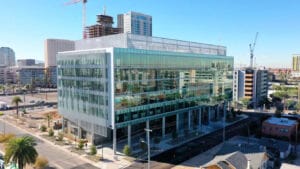As Covid vaccines continue to roll out and restrictions are lifted by Arizona Governor Doug Ducey, CEOs are facing pressure to make decisions about when and how professionals will return to office work.
Reports say that by mid-summer, a good portion of the working-age population should be vaccinated, which will play a significant role in how and when employees go back to work.
“Because of such hopeful signs, CEOs at companies that remained all-remote (during the pandemic) are starting to think seriously about how and how much to bring their employees back to the office, and how to best answer questions about policies and timelines their boards will soon ask,” said Dan Ciampa, a former CEO, and adviser to boards and chief executives.
READ ALSO: 4 major business corridors being driven by West Valley freeways
“They realize that given all that has happened over the last year, more employees than ever before will work remotely, and for tasks that can be done more efficiently that way, investments in technology are necessary,” he said.
Roughly 20% of workers will remain remote employees, according to several studies.
However, if the past year has taught us anything, it is that nothing is as straightforward as it may appear, and returning to “normal” will be a long, arduous process.
In a Feb. 25 Harvard Business Review article, Ciampa said that with all of the uncertainty about what lies ahead, it is important to avoid steps that either will create unrealistic expectations or limit options.
Experts agreed.
Kyle Freese, Ph.D., MPH, chief epidemiologist at Phoenix-based health technology company STChealth and Scott Hamstra, MD, chief medical officer at STChealth and a practicing infectious disease pediatrician, have been consulting for various organizations throughout the country, designing and implementing return-to-workplace strategies.
First, they encourage business owners to seek reliable information and expertise from a variety of sources as they make challenging logistical decisions.
Within the context of return-to-work strategies, employers often make decisions using imperfect, incomplete, or unknown data and interpret literature in subject areas outside their expertise, Freese and Hamstra wrote in a recent opinion piece published in the Phoenix Business Journal.
“There is no “one-size-fits-all” approach for managing risk in the workplace against infectious disease, nor can all businesses adopt remote operations or adapt to changing outbreak characteristics.”
Returning to Work Post Pandemic
As workers prepare to return to the office, productivity, communication, and collaboration is at the forefront of every manager’s mind.
But what can and should employees expect when they return?
Many have become accustomed to the rather short commute from the kitchen to their home office, and those reduced drive times have positively impacted work/life balance.
Across all industries, business leaders are using the lessons from this large-scale, work-from-home experiment to reimagine how work is done — and what role physical offices should play.
According to McKinsey research, 80% of people surveyed reported they enjoyed working from home, and 41% said they are more productive than they had been before; about 28% said they are as productive.
Many workers who were liberated from long commutes and business travel found more productive ways to spend that time, enjoyed greater flexibility in balancing their personal and professional lives, and decided that they prefer to work from home rather than the office.
Commercial real estate experts say new office space is being engineered for maximum social distancing, touch-free operations and air and surface sanitization.
“In addition to those features, employees are looking for practical answers for how they will safely navigate the workplace upon their return, said Paul Komadina, Phoenix-based Senior Managing Director at CBRE.
CBRE’s Komadina said regardless of how workspaces are being configured, offices are being prepared for near-term occupancy with Covid-19 safety protocols and considerations in mind.
According to the most recent data from CBRE, 93% of the firm’s clients are preparing for office re-entry with social distancing floorplans; 93% are also implementing an increased/modified cleaning schedule; and 74% have a phased re-entry plan. Additionally, CBRE property management professionals are reporting a shift in the most sought-after building amenities.
“Features such as enhanced indoor air quality, touchless technologies, and outdoor amenities have increased in popularity because of Covid,” Komadina said.
So, will open floor plans and multiple common areas revert back to cubicles and private offices?
Komadina said no.
“Open-plan’” as a design strategy has often been misunderstood (or poorly implemented) to mean a sea of cubicles without space for private conversations, focus work, or solitude. There is no question that such imbalance in a workplace leads to dysfunction. However, the reaction cannot be to give everyone their own private office,” he said.
“Aside from being inefficient, this would also have a detrimental impact on office energy, collaboration, and relationship building. Additionally, private offices are not a silver bullet against spreading germs and disease,” Komadina added. “Whether you work in an open workstation environment or from a private office, you are sharing elevators, bathrooms, conference rooms, coffee pots and the air you breathe with the rest of the workplace, so office health and well-being programs need to be holistic.”
Komadina said many of the frequently asked questions he fields center around elevator protocol, access to PPE and conflict resolution for mask mandate rule breakers.
“Ultimately though, factors outside of employer control such as vaccination status, childcare/eldercare responsibilities, and safety of public transportation may have greater influence on employee willingness to return to the office,” he said.
Trends in Employment and Growing West Valley Industries
Demand for industrial space in the West Valley was growing before the COVID-19 pandemic, but the rise of e-commerce and strain on the supply chain over the past year has made the need for industrial space a top priority for business.
“Throughout the pandemic, the West Valley has continued to attract new companies,” said Sintra Hoffman, president and CEO of WESTMARC, a public-private coalition of 15 West Valley communities. “While many small businesses were impacted, larger companies in health care, manufacturing and logistics increased their investments to meet changing consumer behaviors,” she said.
And with the announcement by Taiwan Semiconductor Manufacturing Co. Ltd that it is developing 1,128 acres located near the northwest corner of Loop 303 and the 43rd Avenue alignment, new life has been breathed into the region’s tech sector.
Taiwan Semiconductor makes silicon chips for Apple Inc. and several other major technology companies. In March, it was reported that the company’s planned West Phoenix manufacturing plant would likely be three times larger than originally announced.
The Southwest Valley region leads the Phoenix metro with 4.8 million square feet of positive net absorption during the first three quarters of 2020, including nearly 2 million square feet absorbed by multinational companies, according to data from Cushman & Wakefield.
In addition to residential, retail and manufacturing, medical office and specialty health care development has been scooping up real estate in the West Valley for growth and expansion. One of those projects is the Akos medical campus in the Avondale Health-Tech Corridor north of Interstate 10.
The Avondale Health-Tech Corridor was primed to develop a new class-A medical campus,” said Timothy Cozatt, investor relations officer for Akos.
The new medical campus estimates between 500-600 net new high-wage jobs for physicians, nurses, technologists and support staff in Avondale and Surprise. That number is expected to grow as more businesses take space on the campus, Cozatt said.
Officials in Avondale also recently announced significant health care locates with the expansion of Phoenix Children’s Hospital and ClearSky Rehabilitation Hospital.
Additionally, Banner Health recently added a $53 million Glendale health center — one of its largest — to its portfolio of growing properties throughout the Valley.
The newly built facility, at 128,000 square feet, has 128 exam rooms and 13 imaging rooms. It is two to three times larger than Banner’s second-largest health center, located in Peoria and employs 215 health care professionals.
Banner also opened a $28 million rehabilitation hospital in Peoria, and it is spending $106 million on expanding its Banner Boswell Medical Center in Sun City. That project, which will include a new emergency department and new patient tower, is expected to be completed in Q2 of this year.
Deeper Talent Pools
From commercial and residential real estate to health care and finance to manufacturing and logistics, the West Valley has exploded with opportunity.
In fact, more than 30% of the professional finance and insurance workers in Maricopa County live in the West Valley.
About 80,000 people moved to metro Phoenix between 2019-2020. California, alone, lost 60,000 residents last year, according to Census data, most of whom moved to Arizona. The state also is seeing more migration from New York, Texas and other large, more expensive states. Many of these newcomers have opted to live in the West Valley.
With higher home prices in the East Valley, and the median age of West Valley residents just 35 years old, Hoffman said West Valley cities are creating “a place people want to call home.”
Many companies will be able to access new pools of talent with fewer location constraints, adopt innovative processes to boost productivity, create an even stronger culture and significantly reduce real-estate costs.
“Returning employees want suburban office environments, and the workforce is already here and now need to work close to home,” Hoffman said. “They’re not doing the commute.”
West Valley Opportunities
Opportunities in the West Valley for Class A office space has been limited, but one of the newest projects to come online in Goodyear will include 100,000 square feet of Class A speculative office space.
“People in the West Valley have been talking about Class A spec office space, but we’re the only group building it,” said Mike Olsen, CFO of Globe Corp.
The city of Goodyear and Scottsdale-based Globe Corp. formed a public-private partnership to develop 47 acres owned by Globe near 150th Drive and McDowell Road. The projects will include a 120,000-square-foot building housing Goodyear City Hall and city departments, a civic park and the spec class A office space.
The suburban “office renaissance” has made the West Valley — Goodyear in particular — a popular place to build, Olsen said.
This type of highly desirable, upscale office product will attract the type of companies that bring high-quality jobs, said Goodyear City Manager Julie Arendall.
“The ability to attract large office users expands the daytime employee base in Goodyear, which increases the attractiveness for new restaurants, retail and entertainment,” she said.
According to a study by CBRE, 95 percent of the workforce in Goodyear commutes to downtown Phoenix. The oftentimes brutal Interstate 10 drive into work in one reason Olsen is optimistic about the Globe project.
“Having the city of Goodyear as partner made it easier to build the project on spec,” he said. “While Goodyear is nationally recognized as a hotspot for industrial development, we felt like we could pull in a corporate tenant.”
While Olsen couldn’t disclose which companies CBRE was targeting for the new office space, he did say a small finance firm has already reached out to him.
Groundbreaking for the Globe project will be April 23, and Olsen said it is expected to be completed in mid-2022. Globe already is beginning to work on branding and on the retail space that will be part of the overall project.
Olsen said his team also is talking with several Scottsdale and East Valley communities, such as Gilbert, about replicating some of their restaurant and retail options at GSQ-Goodyear, the new official name of the project.
The first phase includes the city hall and the Class A office space, and it is expected to be finished in June, but Olsen said Globe is working to finish the civic park area by November to commemorate the city of Goodyear’s 75th anniversary with a celebration in the park.
Reimagined Workspaces
As a result of the pandemic and more than a year of work-at-home scenarios, companies are rethinking space needs going forward. Corporate headquarters are giving way to satellite offices around the Valley now that the concept of remote work is a productive and, for some, a welcome reality.
There are a number of opportunities throughout the West Valley for shared, reimagined and reuse spaces, which usually is much less of an investment for companies, said Hoffman, adding that the West Valley has a strong and talented workforce with 32% of advance business workers residing in the region. This presents many options for satellite offices in existing, reuse or new spaces.
For example, in late 2019, San Diego real estate developer PMB converted the former Dickinson Palm Valley 14 movie theater in Goodyear into a medical plaza, a “uniquely challenging adaptive reuse project” according to Mark Toothacre, president of PMB.
The project repurposed the 50,000-square-foot, 1980s-era multiplex movie theater into a 188-bed acute-care community hospital and Level 1 Trauma center operated by the Phoenix-based Abrazo Community Health Network.
“The finished product incorporated high-profile features that rival new, build-to-suit medical office buildings, but our strategic adaptive reuse approach delivered a gorgeous facility on a construction schedule half that of a ground-up project,” Toothacre said.
Goodyear Mayor Georgia Lord said in a recent interview that the project is a good example of repurposing an empty building and turning it into vibrant office space.
Toothacre said PMB pursued the unique conversion in response to the need for Class A medical office space in the region. The building expanded Abrazo West Campus’ wound care program, and provides outpatient services such as imaging, internal medicine, pain management and physical therapy.
As part of the adaptive reuse, PMB retained the former theater’s generous 12-foot-wide common hallways to create a patient-centric public corridor and added a completely reworked building entry. PMB also took advantage of the 22-foot ceiling heights to create open spaces with great future flexibility.
“The newly revitalized structure enhances the area and brings new jobs and opportunity for growth to the Goodyear Medical Innovation Corridor,” Lord said.





